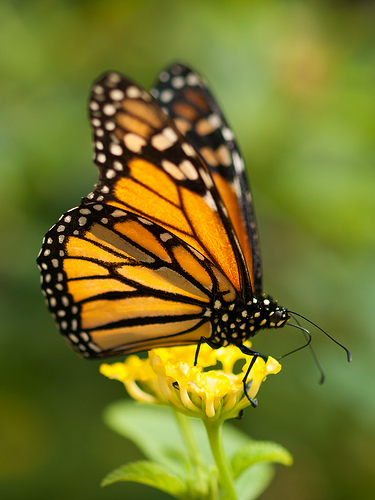Be warned when the monarch butterfly displays its bright wings.
- A monarch butterfly is a species of common and easily recognisable butterfly, native to North America, though they are now found in a number of countries around the world.
- ‘Monarch butterflies’ are also known as ‘milkweeds’, ‘common tigers’, ‘monarchs’, ‘black veined browns’, ‘King Billies’ and ‘wanderers’.
- The scientific name of the monarch butterfly is Danaus plexippus and it is from the family Nymphalidae, the family of brush-footed butterflies.
- The wingspan of monarch butterflies typically extends a distance of 8.6 to 12.4 centimetres (3.4 to 4.9 inches), and they generally travel thousands of kilometres each year, when they migrate to warmer areas in autumn where they overwinter.
- Monarch butterflies are a distinctive orange and black colour, and sometimes white and black, though this is rare, with white spots decorating the wing borders; a pattern similar to that of the viceroy butterfly.
Monarch Butterfly
Image courtesy of William Warby/Flickr
- The diet of the monarch butterfly caterpillar consists of mainly milkweed leaves, from various species in the Asclepias genus, while the butterfly will feed on nectar from various flowers including milkweed.
- After hatching from an egg, it takes roughly 9 to 14 days for a monarch butterfly caterpillar to moult and form into a chrysalis, while it takes 9 to 15 days for the butterfly to emerge from the chrysalis.
- Monarch butterfly larvae or caterpillars are generally patterned with yellow, white and black stripes, while the chrysalis is mostly green with the odd yellow speck.
- The taste of monarch butterfly is particularly putrid and potentially poisonous towards many possible predators as a result of the insect’s milkweed diet.
- Monarch butterfly caterpillars were taken to the International Space Station in 2009, where the specimens both lived and emerged from their chrysalis under the watchful eye of scientists.
Bibliography:
Danaus plexippus, 1999, Animal Diversity Web, http://animaldiversity.org/accounts/Danaus_plexippus/
Monarch Butterfly, 2015, Wikipedia, https://en.wikipedia.org/wiki/Monarch_butterfly
Monarch Butterfly (Danaus Plexippus), n.d., Wildscreen Arkive, http://www.arkive.org/monarch-butterfly/danaus-plexippus/







